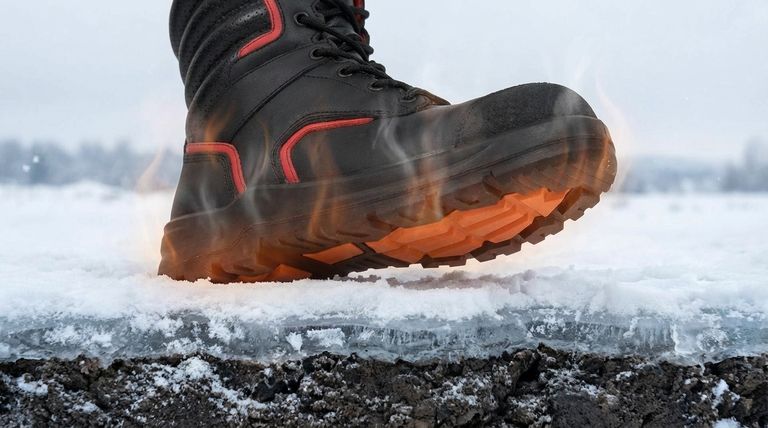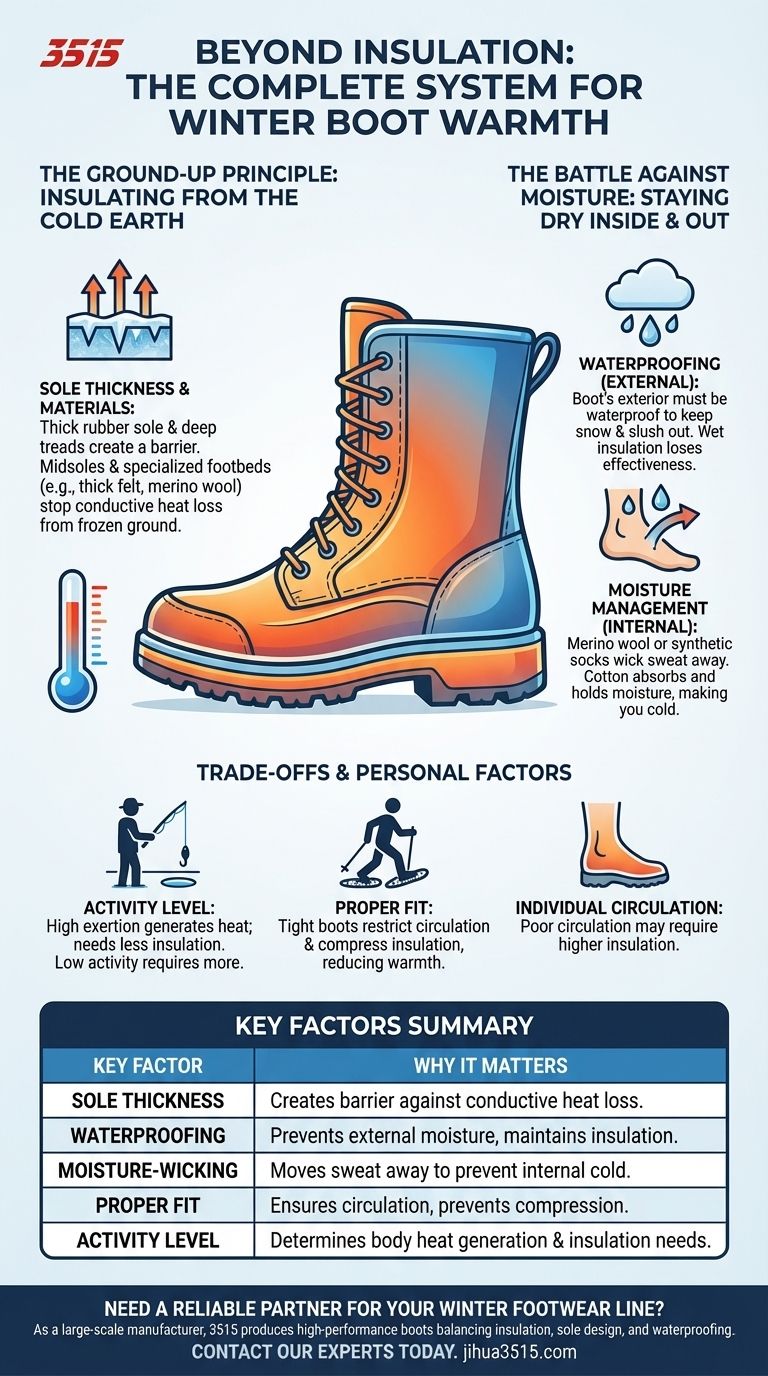Beyond the insulation rating, the true warmth of a winter boot is determined by a complete system of features working together. Factors like waterproofing, the thickness of the sole, the materials used in the lining, and how you manage moisture with your socks are often just as critical as the grams of synthetic insulation.
A truly warm winter boot is an integrated system designed to combat heat loss from all angles. Focusing only on the insulation rating while ignoring heat lost to the ground or from moisture will almost certainly lead to cold feet.

The Ground-Up Principle: Insulating from the Cold Earth
The most overlooked source of heat loss is direct contact with the frozen ground. The earth acts as a massive heat sink, constantly pulling warmth from your feet through a process called conduction.
Why Sole Thickness is Non-Negotiable
A thick sole, especially one made from rubber with deep treads, creates a physical barrier between your foot and the cold ground. This distance is crucial for slowing heat transfer.
Thin, flexible soles may be comfortable for walking, but they offer minimal protection from persistent cold radiating from snow and ice.
The Critical Role of Midsoles and Footbeds
Many high-quality boots build insulation directly into the midsole or include specialized footbeds.
Materials like thick felt or merino wool in an insole can add a significant layer of underfoot protection, stopping cold before it ever reaches your sock.
The Battle Against Moisture: Staying Dry Inside and Out
Water is warmth's greatest enemy. It transfers heat away from your body up to 25 times faster than air, making moisture management essential.
External Protection: The Importance of Waterproofing
A boot's exterior must be waterproof to prevent snow, slush, and water from ever reaching your foot.
Once your sock or the boot's internal lining gets wet from an external source, even the best insulation becomes dramatically less effective.
Internal Moisture Management: Your Socks are Key
Your feet sweat, even in the cold. If that moisture is trapped, it will make your feet cold.
Socks made from merino wool or synthetic materials are critical because they pull (or "wick") sweat away from your skin. Cotton socks do the opposite; they absorb moisture and hold it against your foot, actively making you colder.
Understanding the Trade-offs and Personal Factors
A boot's effectiveness is not absolute; it depends on how and where you use it. What works for one person may not work for another.
Activity Level vs. Insulation
Your activity level generates heat. Someone standing still for hours (like for ice fishing) needs far more insulation than someone actively winter hiking.
Some experienced hikers even prefer non-insulated waterproof boots, allowing them to customize their warmth by pairing them with different thicknesses of wool socks to match the day's conditions and their exertion level.
The Problem of a Tight Fit
A boot that is too tight is a cold boot. A snug fit restricts blood circulation, which is vital for keeping your extremities warm.
Furthermore, a tight fit compresses the loft of both your sock and the boot's insulation, dramatically reducing their ability to trap warm air.
Individual Circulation
Physiology plays a role. People with naturally poor circulation may need to select boots with higher insulation ratings and thicker soles than others for the same conditions.
Making the Right Choice for Your Goal
Select a boot by evaluating the entire system against your specific needs.
- If your primary focus is extreme cold with low activity (e.g., ice fishing, spectating): Prioritize maximum sole thickness and a high insulation rating (400g and above).
- If your primary focus is active use (e.g., winter hiking, snowshoeing): Balance moderate insulation with excellent waterproofing and a system of moisture-wicking socks.
- If your primary focus is everyday commuting: Look for a blend of waterproofing, decent sole insulation, and moderate warmth that won't cause overheating indoors.
Thinking of your winter boot as a complete warmth system—not just a number—is the key to truly warm feet.
Summary Table:
| Key Factor | Why It Matters for Warmth |
|---|---|
| Sole Thickness | Creates a barrier against conductive heat loss to the cold ground. |
| Waterproofing | Prevents external moisture from wetting insulation, which drastically reduces effectiveness. |
| Moisture-Wicking Lining/Socks | Moves sweat away from skin to prevent internal moisture from making feet cold. |
| Proper Fit | Ensures good blood circulation and prevents compression of insulation layers. |
| Activity Level | Determines how much internal body heat is generated, affecting insulation needs. |
Need a reliable partner for your winter footwear line?
As a large-scale manufacturer, 3515 produces a comprehensive range of high-performance boots for distributors, brand owners, and bulk clients. We understand the engineering behind true warmth and can manufacture boots that perfectly balance insulation, sole design, and waterproofing for your target market.
Contact our experts today to discuss your manufacturing needs and how we can help you deliver superior cold-weather footwear.
Visual Guide

Related Products
- Premium Wholesale Waterproof Safety Boots High Performance Protection for Industrial Markets
- Customizable Anti-Smash Safety Boots for Wholesale & Private Label Manufacturing
- High Performance Fire-Retardant Waterproof Safety Boots
- Custom Wholesale Leather Safety Boots Direct Factory Manufacturing
- Premium Grain Leather Safety Boots for Bulk Supply
People Also Ask
- What are the key considerations when choosing safety boots? Match Hazards to Features for Maximum Protection
- What boots do they wear on oil rigs? Essential Safety Footwear for Harsh Conditions
- What is a safety-toe in a boot? Your Guide to Choosing the Right Protection
- How do safety shoes protect you? A Guide to Essential Footwear Safety Features
- Is there a downside to steel toe boots? Weighing Protection Against Daily Comfort



















